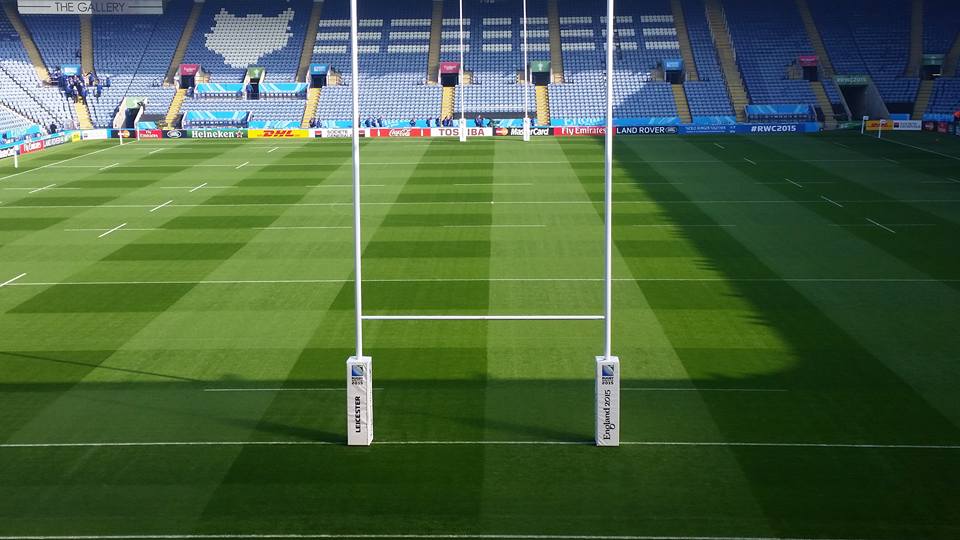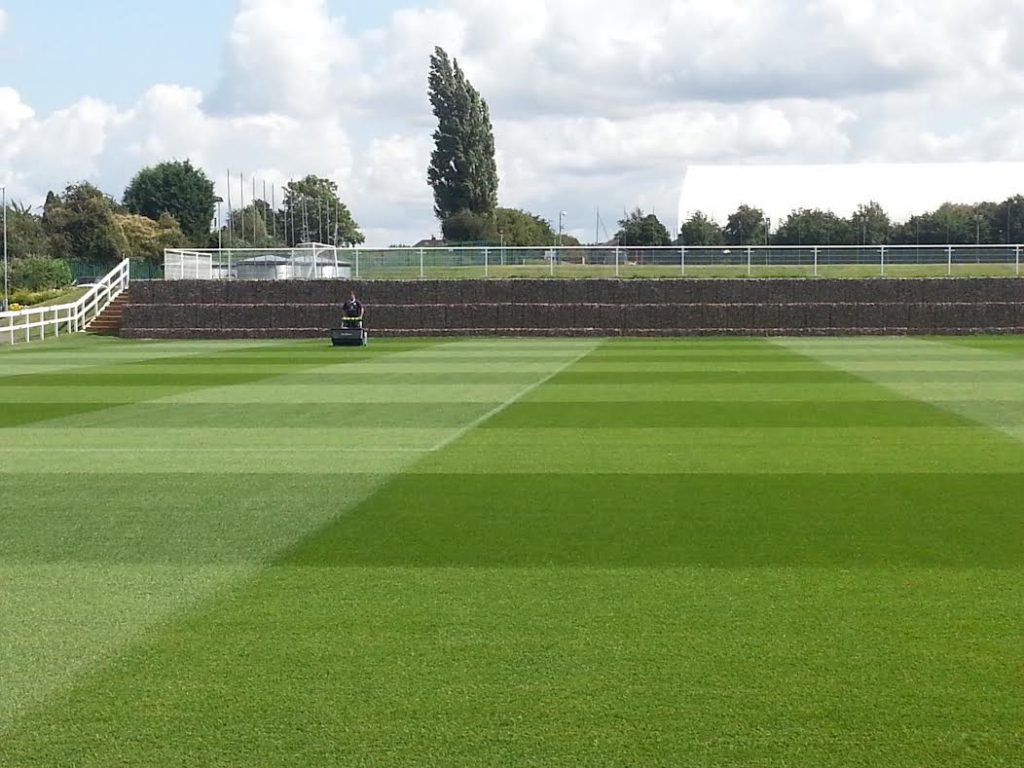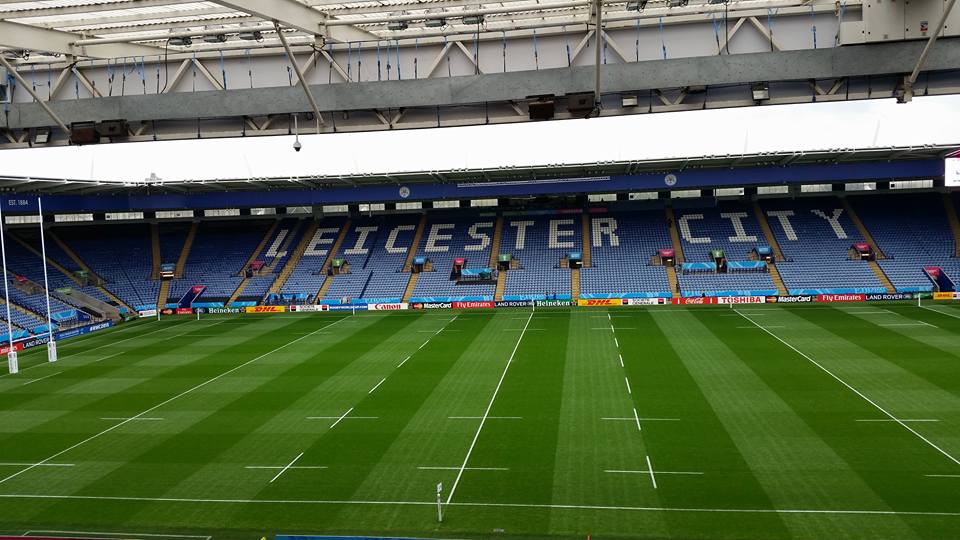- February 9, 2017
- Posted by: SportsV
- Categories: Features, Home News, Industry News, Interviews, News

In this latest industry interview, Katie McIntyre chats with John Ledwidge, recently promoted to Grounds Manager at Leicester City Football Club (LCFC), and who was only last month named the second most influential figure in the Turf Care industry.
Firstly, congratulations on being named the ‘Second most influential figure in the turf care industry’, as voted for by Turf Business readers. How does it feel securing such recognition from your peers?
I believe it is always an honour to be recognised on any level within this industry, whether it through a vote or even a “well done” from your team. Even being in amongst the other candidates was a great feeling and then to come second was a great honour. Richard Campey even had medals made that he presented at the STMA conference!
As Grounds Manager for the phoenix-like Leicester City FC (LCFC), who beat all the odds and took the English Premier League (EPL) crown, you are responsible for keeping both the turf at King Power Stadium and the club’s training pitches in tip top condition. Can you tell us a little about the main challenges you face on a daily basis and how you overcome them?
For us as a department, we strive to provide the highest level of playing surfaces both at the training ground and at the stadium. This is only made possible by my fantastic team and the support of the club with resource. The daily challenge for us is that we work with the weather and the Gods above make our job and best laid plans subject to change. We plan accurately and then have to work with whatever is thrown at us and I feel my staff cope and adapt well.
What role does technology play in keeping the playing turf in perfect condition? And what kind(/s) of turf solution(/s) do you have installed at King Power and the training pitches? i.e. natural grass/hybrid/artificial, sub soil aeration/heating system, do you use grow lights, etc?
Technology is ever evolving and I feel that we as groundsmen and as an industry must embrace this, whilst understanding there is an element of good judgement and experience that all come together to help us produce the highest standards. The evolution of turf technology, with hybrid pitches, lighting rigs and products that we apply to the turf has made us all more like mad scientists and botanists. This coupled with skill and hard work makes our industry one of the most diverse and interesting. At the King Power, we have a Desso Grassmaster pitch basically meaning that 4% of the surface is made up of synthetic fibres stitched to a depth of 180mm, this offers the surface to remain stable and safe even if we lose the grass cover. We have a full SGL system of lighting rigs that really help us to grow and recover the grass plant all year round. We closely monitor the conditions of all our pitches on a daily if not hourly basis and I could write an essay on the technology and rigorous record keeping we apply but I feel that with a mix of technology and skill the modern day groundsman is gaining more and more professionalism to deliver to the highest standards that are fast becoming the “norm”.
What are the key elements of your Pitch Management plan? How important is it to have a concise plan in place? And what are the specific challenges of managing natural grass as opposed to reinforced pitches?
At LCFC, we meticulously plan and record our day-to-day activities. Each member of the team has a valid and valuable input to the team and its operation and I feel this is important to the success of our department. The key elements are timings of operations and knowing the importance of sometime when Not to do something is just as crucial as knowing when to. Reinforced pitches and natural pitches are similar in management, it is more dependent on the construction of these pitches that dictate how intensely you manage your fertilizer programmes and operations.


How do you keep yourself up-to-date regarding all the latest technological advances, best practices, etc?
I always have my ear to the ground and share best practice with colleagues. I also spend most of my free time researching products or machines that could improve what we do. Much to my fiancées dismay, you will find me of an evening looking at turf-related articles, documents or research papers. I’m a bit obsessed but this industry is a lifestyle as much as a career.
You must have witnessed many advances in the Turf sector over the last decade. Which do you feel have had the biggest and most important impact? And what kinds of developments would be most beneficial to the industry moving forward?
The turf industry has become so much more professional over the last decade. Grow Lights and Desso Grassmaster have been the real game changers but I feel that the advanced techniques in which we manage these surfaces is the real achievement for our industry. We can be given all the tools in the world but if they are not applied correctly, they won’t succeed. So, I would say most significant is the companies providing the tools and educating the staff using them and commitment to research and development by working with the end user. Moving forward, I believe it is incremental changes. At LCFC, we are always looking at improving by the 1% that may give our pitch the edge so the players can be at their optimum.
If you could give one piece of advice to an industry colleague or someone aspiring to become a Grounds Manager, what would it be and why?
The Game is changing, at the top we are managing surfaces that can have upwards of £500m of assets playing on them, we will become liable and accountable for our actions so never take your foot off the gas, always strive to be better, be respectful, educate people that want to learn and ALWAYS let your playing surfaces do the talking for you.
What are your thoughts regarding knowledge-sharing between industry peers?
We are part of a great industry. Full of people that want to learn and share ideas, and it really is easy to access information because we are quite open. I would like to believe that if anyone at any level thought they could learn something from us here at LCFC, then the door is wide open for them to do that.
Finally, the Foxes may have been the centre of attention following their EPL title win, but the elaborate pitch patterns that kept appearing at King Power Stadium certainly didn’t go unnoticed either, especially the poppy design for Remembrance Day. What made you decide to try out different patterns and how much extra time and care do you need to put in to achieve this?
These things do take time and I think every groundsman up and down the country has had a go at applying some patterns to their pitches. We were fortunate last season to have an amazing platform to showcase what we can do, but the message was clear. I wanted people to talk about our industry and raise the profile for groundsmen who work hard at every level. I have been on both ends of the spectrum, working with little or no resource to now, having what I need to work effectively, so the coverage we got last season was less a self-promotion and more to raise awareness of what a great industry we have, one I’m very proud to be part of.

About John Ledwidge
John began his journey as a 13-year-old volunteer at Coventry City Football Club. His hobby turned into a career when he left for Aston Villa to work under Jonathan Calderwood. At the age of 24, he returned to Coventry City as Head Groundsman of the Ricoh Arena. After 4 years at the helm, experiencing all kind of challenges – from concerts to international and domestic football – he made the move to Leicester City Football Club, where he was appointed Head Groundsman in January 2014, and took control of all the pitches and surrounding grounds at both the Training Facility and Stadium. John was recently promoted to Grounds Manager, and now leads a team of nine and manages over 25 acres. He is a member of the European Stadium & Safety Managers Association (ESSMA) and is involved with their Pitch Management expert group.
On his arrival at LCFC’s King Power Stadium (also known as the Leicester City Stadium due to UEFA sponsorship regulations), John defined a long term pitch improvement plan. The 5-year plan consisted of a GB£3m investment; with GB£1.2m being invested during the first year, an additional £800,000 the year after and by the third year the project was completed thanks to a final investment of GB£1m. The plan did not focus solely on pitch improvements however, with refinements in staffing levels, organisational structure and an increase in salaries also realised. To get the support of the club’s directors, John developed a comprehensible grading system to facilitate the decision-making process. This system allows the board/management of the club to get a good overview of the priorities, timings and costs.
For further details on ESSMA and the Pitch Management expert group, visit: essma.eu
Many thanks to John and to LCFC.


